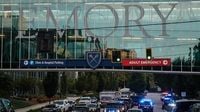Six days have passed since a harrowing shooting rocked the campus of the Centers for Disease Control and Prevention (CDC) in Atlanta, yet the echoes of that violent morning continue to reverberate through the halls—and hearts—of the agency’s employees. On August 8, 2025, the CDC campus became the scene of a chilling attack when Patrick Joseph White, a 30-year-old gunman reportedly motivated by a belief that the COVID-19 vaccine had caused his mental health decline, unleashed more than 180 rounds into several CDC buildings. The barrage shattered about 150 windows, left glass shards scattered across office floors, and, most tragically, claimed the life of DeKalb County Police Officer David Rose, who responded to the scene. White ended the rampage by taking his own life, according to the Georgia Bureau of Investigation.
For many CDC employees, the trauma of that day is far from over. As Atlanta News First reported, the majority of staff have been working remotely since the incident, with management offering flexibility and support to help them grieve. Daniel Perry, a CDC lab employee, returned to the campus for the first time on August 14 to honor Officer Rose’s sacrifice. "I was leaving campus as he opened fire. I was just out of harm’s way, and I thank God for that," Perry recalled, reflecting on his narrow escape. He added, "I had colleagues who were scrambling in buildings trying to get in a safe place." The sense of gratitude for his own safety, Perry said, is overshadowed by the loss of Rose, whose actions saved countless lives that day.
The aftermath has seen the CDC community grappling with a complex mix of shock, anger, and sorrow. "Some people are in shock, some people are angry," Perry shared. Remote work and online support groups organized by human resources have become lifelines for many, with management encouraging staff to return only as they feel ready. "People are trickling in as they can. Our management, they’re being flexible with us at this moment for people to grieve," Perry noted. The healing process, it seems, will be a long road.
While the emotional wounds are raw, the physical scars on the CDC campus are stark reminders of the violence. According to CNN, photos taken from inside one building show bullet holes in windows and shattered glass strewn across the floor, with rounds flying just above office cubicles. PBS reported that the gunfire "spattered glass shards into numerous rooms," yet, remarkably, no CDC staff were physically injured. This outcome, experts suggest, may be due in large part to the blast-resistant glass already installed in the buildings. As highlighted in a 2023 study published in Disaster Resilience and Sustainability of Structures and Infrastructures, flying glass fragments are a leading cause of injury in explosions and shootings—accounting for nearly 75% of injuries in the 1995 Oklahoma City bombing, for example. The blast-resistant glass at the CDC likely prevented the kind of catastrophic shattering that has proven so deadly in past incidents.
Still, the sense of safety has been deeply shaken. The American Federation of Government Employees Local 2883, the union representing CDC staff, has issued an urgent call for enhanced security measures. In a statement on August 11, the union declared, "We will not accept this as ‘business as usual,’ and temporary fixes won't cut it." Their demands are sweeping: installation of bulletproof glass, all-day perimeter security with armed guards, weapons detection procedures, an enhanced alert system, and more robust evacuation planning. "Staff should not be required to work next to bullet holes," the union insisted, underscoring the enduring anxiety among employees.
The distinction between blast-resistant and bulletproof glass has become a focal point in the debate over campus security. As outlined by U.S. Bullet Proofing and Window Film Depot, blast-resistant windows are engineered to absorb the pressure and impulse of an explosion, protecting occupants from flying debris. Bulletproof glass, on the other hand, is specifically designed to resist penetration by bullets, though even it is not entirely impenetrable. The most protective types—polycarbonate and glass-clad polycarbonate—can stop bullets from entering, preventing ricochets and further harm. Laminated glass and acrylic offer varying degrees of resistance but may not be sufficient to halt a determined shooter.
Recently, many schools and institutions have turned to ballistic film as a cost-effective security upgrade. This film, applied to existing glass, can prevent windows from shattering outward but does not actually stop bullets, as Jim Richards, CEO of Total Security Solutions, explained in a commentary for the Security Industry Association. "What this product will do is keep a window from shattering out," Richards said. "It will not stop a bullet." School districts have invested heavily in such films—over $100 million in recent years, according to The Wall Street Journal—but as James Bailey, security supervisor for Hampton City Schools in Virginia, acknowledged, "We know that it’s not bulletproof film. We are trying to buy time if there was a serious incident."
For the CDC, the union’s demands for bulletproof glass and other security enhancements remain unanswered as of August 12. CDC Director Susan Monarez, in a statement, expressed gratitude for "the swift response of CDC security and local law enforcement" and emphasized the agency’s commitment to supporting staff. "Friday’s shooting was a traumatic event for the agency, and leadership is working to provide continued updates along with resources for healing and recovery," Department of Health and Human Services spokesperson Andrew Nixon told CNN. "There will be continued opportunities for staff engagement and dialogue in the days ahead."
The path forward is uncertain. While the blast-resistant glass may have prevented a far greater tragedy, the union and many employees believe that more must be done to ensure their safety. The trauma of August 8 has left a mark not just on the buildings, but on the psyche of the CDC community. As Daniel Perry and his colleagues slowly return to campus, the memory of Officer David Rose’s bravery serves as both a comfort and a call to action. The question now is whether the CDC will heed that call, investing in the security measures that staff say are essential for their peace of mind—and their lives.
The events at the CDC have sparked a broader conversation about workplace safety in an era marked by rising threats. As the agency works to repair broken windows and shattered trust, its employees are left to navigate a new reality—one where vigilance and resilience are as vital as ever.





